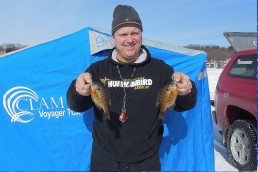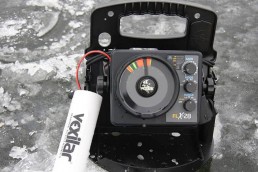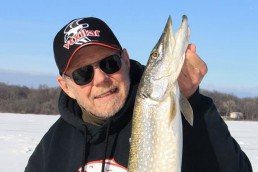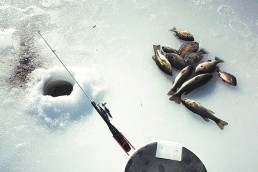Midwinter Panfish
SHARE THIS POST
“Fish coming up out of the weeds after my bait right away,” my son Parker said excitedly. I had gotten his Humminbird set up in the hole and a couple Eurolarvae on his jig first so he could start fishing even before I got my hole scooped out. “Got one!” Parker laughed. Seconds later, a 10-inch crappie came up the hole. “Fish coming right to my bait,” my Dad said as he got his flasher going and his bait down to the four feet or so of weeds growing up from the bottom. As my Dad lifted an eight-inch sunfish out of his hole, I released Parker’s crappie and he dropped his bait back down the hole. I noticed fish coming up out of the weeds to meet his jig and chuckled to my Dad, “I might not even get a bait down for a while.” “Got one!” Parker said, and my Dad and I just smiled at each other.
Midwinter fishing for sunfish and crappies can be fast, slow, or in-between action. Often there are spurts of fast action separated by lulls of inactivity. When the fish are on, like they were in the opening, you have to take advantage while you can. Often, there will be peak bites close to sunrise and sunset—especially for crappies. Often, there will be a mid-to-late morning bite for sunfish, and/or a mid-afternoon bite. In addition, crappies may bite well after dark or well before sunrise. You’ll figure out the patterns for your lake and the spots on it as you go along. If you can stay out all day, fishing the peaks and waiting out the lulls, you can have a wonderful time. We often bring a grill and some burgers or brats for lunch and a football to throw around during the lulls.
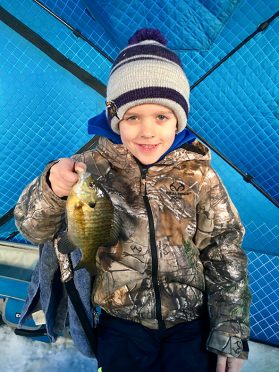
Searching out some bites
Where to look for these midwinter panfish varies by the lake and the weather. A typical pattern for Midwestern lakes would be to fish shallow, over or near weeds, early in the ice season, and then move to the deep basin areas of a lake when midwinter arrives. As the ice thickens and the snow piles up, the shallow weeds die off and the dissolved oxygen levels drop. Panfish move to the deep basin areas with plenty of dissolved oxygen, warmer water, and soft-bottom larvae activity during this part of winter. This pattern, is not set-in-stone, however.
The past few winters have been fairly tame in my home state of Minnesota. We have had late ice-ups, less ice, and less snow than normal. This leads to the weeds staying greener, longer, than normal, which leads to enough dissolved oxygen to keep minnows and panfish in and over the shallow to mid-depth weed flats all winter.
The last few years, with the unusual weather, I have noticed water temps (recorded on my underwater camera) remaining as warm, or almost as warm, in shallow, weedy areas as in the deeper water of the lake basin. Result: we have found plenty of sunfish and crappies, including large ones, remaining all winter in and over the weeds on the shallow and mid-depth areas that we normally fish only early and late in the winter. While there were still lots of panfish that moved to the deep-basin areas, we stayed on the shallower fish as they tend to be more active more times of the day. You will have to pattern the fish on your lake each year, but these situations should give you some guidelines to work from.

Finding finicky fish
Once you locate sunnies and crappies, you will need to figure out how to catch them. Whether shallow or deep, most Midwestern lakes experience their clearest water of the year during this time. This means you have to be stealthy. It is often difficult to believe how finicky sunfish and crappies can be during midwinter. Yes, these are the same fish that will hit almost anything aggressively during the spring and summer months.
Midwinter, you have to go small and subtle. For shallow water, I go with a 1/64-ounce fluttering jig like a Custom Jigs and Spins Gill Pill. I will tip this with a single waxworm or two red Eurolarvae if the fish are fussy. If the fish are aggressive, a tiny soft plastic like a 1-inch Berkley Gulp Fish Fry will often do the trick and save you time rebaiting.
When fishing deeper water, you need to go heavier to get the bait back down quickly after catching a fish, but you still need to stay small. This is where tungsten jigs shine. My favorite choice for deep-water panfish, a 1/32-ounce VMC Tungsten Tubby, is the same size as a 1/64-ounce lead jig but gets down to the deep water much faster since it is twice as heavy. I can’t stress the value of these tungsten ice-fishing jigs enough. When fishing deep water for finicky panfish, they make you a better angler—period.
Are you enjoying this post?
You can be among the first to get the latest info on where to go, what to use and how to use it!
Finding colors that click
As far as colors go, you will have to experiment. Early and late in the day, I like to use a glow white jig that I can charge up with the tazer on my lanyard. I have no doubt that a glowing jig triggers more bites in the darkness of early morning, late afternoon and evening, or nighttime. During the daytime, experiment with different colors. If there are multiple anglers, each try a different color. Basic colors to have jigs in your box would be glow white, chartreuse, pink, orange, and mixes of these colors. Two of my favorite color combinations are orange, chartreuse, and white; and pink, chartreuse, and white. Some days color won’t matter, and some days you will definitely find a preference.
Once you do find a hot color, replicate it with all anglers until the bite slows, and then change it up again. Different light conditions caused by clouds and sun or time of day can make one color more attractive than another. Be flexible and adapt to changing conditions. As mentioned earlier, I always have waxworms (white) and red Eurolarvae to tip the jigs. As far as soft plastics go, I carry 1-inch orange, white, pink, and chartreuse baits. On days, or times of the day, when the fish are aggressive, these tiny soft-plastic offerings on a jig will often outfish live bait.

Ultralight presentations
I present these baits with an ultralight rod, reel and line combination. I love the new St. Croix Legend Black ice rods. For these finicky panfish, the 24-inch ultralight model with the adjustable stainless-steel strike indicator presents a light bait nicely. It allows you to detect even the most-subtle of bites. I pair my ultralight panfish rods with an inline ice reel.
These reels are one of the more helpful innovations to hit the ice-fishing market in a while. Line lays flat on these reels and comes straight off, much like a baitcast reel, but these reels hang underneath a rod like a spinning reel. This gives you the balance of a spinning combo without the line twist that comes from spinning gear. I spool this reel with 2-pound-test Berkley Vanish fluorocarbon, which is virtually invisible underwater and hangs nice and straight with tiny, light jigs. The lack of line twist due to the inline ice reel largely reduces spinning of a tiny ice jig on light line.
While using spinning gear with light jigs, especially in deep water with more line out, I have observed small ice jigs spinning due to line twist on an underwater camera. Countless times I observed a spinning jig spook sunfish and crappies, costing me bites. Since, I have observed a lack of spinning by my jigs while using an inline reel. I can’t overemphasize the importance of using these inline ice reels for fishing with tiny jigs.
Spotting the fish
Speaking of underwater cameras, the final equipment needed for these midwinter panfish would be either an underwater camera or a good ice-fishing sonar. I love my Humminbird ICE Helix 7, which not only has mapping GPS for me to find a spot, but also a flasher or regular sonar view to see and trigger these finicky fish. My clients use Humminbird ICE 55 flasher units. These are the best, multi-color ice-fishing flasher sonar units I have ever used.
There are a lot of sunfish and crappies to be caught during the midwinter months. Locate the fish, either over mid-depth weeds or deep, soft-bottom basin areas, get a tiny jig tipped with live bait or a small soft plastic down to fish you see on your sonar or underwater camera, and have a blast. Wait out the lulls, enjoy the spurts, and keep a few fish for a fresh meal if so inclined. Good luck, and I will see you out there somewhere.
MWO
SHARE THIS POST
Did you enjoy this post?
You can be among the first to get the latest info on where to go, what to use and how to use it!
Troy Smutka
Troy Smutka is a central Minnesota fishing guide (greatdayonthewater.com) and a walleye tournament angler. He is also a member of the Lund Boats, Mercury Outboards and Johnson Outdoors Pro Teams, and hosts and produces Fishing and Hunting the North Country on YouTube.
